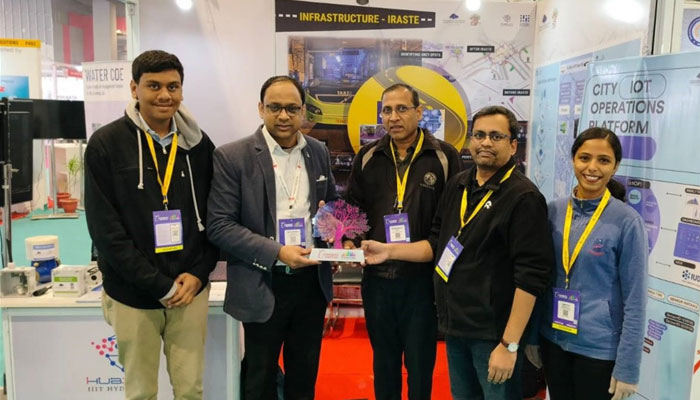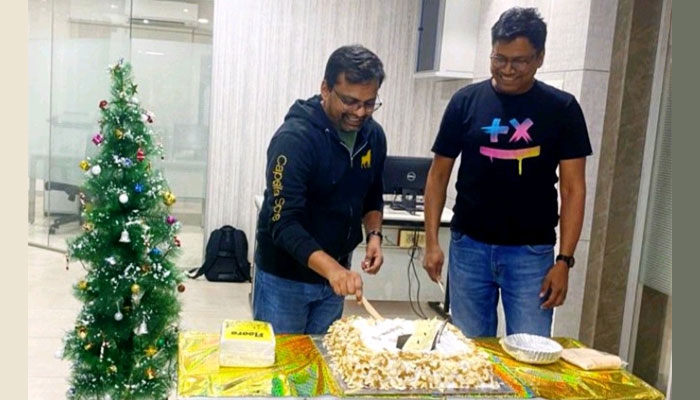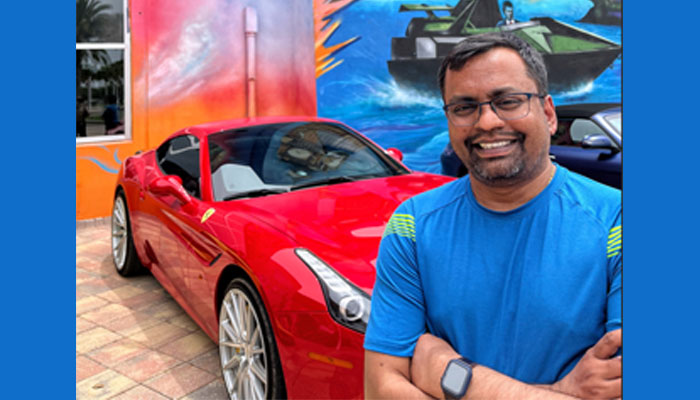Technical acumen, strategic thinking and leadership qualities. IHub-Data CTO Dr. Veera Ganesh Yalla makes it patently clear he possesses all these while revealing that he’s quintessentially a family man at heart.
When Ganesh Yalla set out to embark on what was to be an eventful engineering odyssey, he made sure to select a college that was no further away than 50 kms from his home. “That’s the kind of person I am,” he admits. In fact his decisions for pursuing higher studies too would go on to be based on the same need for physical proximity to family and friends. His introductory exposure to computer vision and machine learning during his Master’s and PhD years would prove later to be his bread and butter. “My core technology area hasn’t really changed over the years. It’s just that the application domains kept changing,” he explains. He attributes his foray into the industrial sector to his passion for product development. When the pursuit of autonomous vehicles was picking up steam in the US thanks to the DARPA challenge – a competition funded by the Defense Advanced Research Projects Agency – Ganesh decided to switch gears himself. His natural proclivity towards the automotive sector found him an excellent fit at Toyota Motors. “I’m a huge fan of cars,” he grins. Not surprising then that of the whopping 35 patents to his name, a vast majority are 4-wheeler-related, something he attributes to the mentorship he received at Toyota under Dr. Roger Melen who is a senior advisor and a renowned early Silicon Valley Tech Innovator. After a 91/2 year-long-stint in the auto industry, inspired in part by his own father’s career with ISRO and fuelled by an itch to do something different, Ganesh found himself working on remote sensing. When the pandemic struck, among many other things was a deep-seated urge to return to the motherland. “The parents are getting old and I wanted to take a sabbatical,” he proffers. A break though was not meant to be as he found himself at the helm of the engineering team at IHub-Data, IIITH.
In an exclusive interaction, Dr. Yalla discusses patents, the inspiration behind his leadership style and tech trends to expect in 2024. Here are edited excerpts.
Q: How would you describe yourself?
A tech geek. Basically all of my career and professional life, I’ve been associated with the technology side of things, specifically deep tech. In fact, even when I go home after work, I like experimenting with and building things. For instance, I have built a multi-GPU computer that I play around with. I’m not much of a gaming guy but I do try to learn whatever’s out there.
Q: You are known as an inventor holding no less than 35 patents. How did that happen?
The whole idea of patenting is to protect your IP. So most of the patents I hold are related to the products that I was working on. From an industry perspective, it particularly helps when companies are working on similar ideas so they can be protected. It’s very common in industry to have a mutual understanding of exchanging patents because oftentimes you cannot build a product without having access to all the ideas. Very rarely does one come across an entirely novel idea that no one has ever thought of. In this day and age, most of the patents are mostly building on top of one another. That said, it was during my PhD that I worked on a really novel patent. We were able to show proof of concept of scanners that captured 3D fingerprint ridges in a non-contact manner. Luckily for us, the Department of Homeland Security in the US was looking for something similar due to the war in Afghanistan where they required contactless fingerprint capturing for cultural & religious reasons. I was part of that effort with my PhD advisor Dr. Laurence G Hassebrook from the University of Kentucky. That was a complete breakthrough but that’s also rare. Most of my other patents are application patents and are related to things that can enhance driver experience.
Q: What is your role in the IHub-Data ecosystem, amidst researchers, technologists, entrepreneurs, practitioners and so on?
As a CTO, my goal is to provide the direction and vision for all of the technology-related components, be it engineering or technology in general. It also includes facilitating the teams with the resources they need in order to be successful. There are two parts to the role; one is inward looking where I’m trying to help my teams and the other is outward looking where I’m trying to understand the technology gap that we’re having with the outside world. I like to think of it as bridging the gap between the inside and the outside by interacting with different stakeholders, including the government because the IHub-Data is a DST-funded entity.
Q: Can you tell us a little more about IHub-Data?
You may know that there are 25 innovation hubs that the DST funded. The reason we are called IHub-Data is thanks to the data-centric focus for our hub. So from data banks, data analytics, to data services, our core focus is on data. And for that we have built a Data Foundation team. We are working in the direction of creating a data centre type of experience for not only internal stakeholders but external ones such as the other innovation hubs that want to use the data centre. We have also recently set up the VIKAS organisation which essentially stands for Vision, Innovation, Knowledge, Adaptation and Success. The Hub actively gives grants to other institutions and supports initiatives via a number of projects. The idea is that through the initiatives if there is any promising technology, our engineering team can help take the concept ideas within a limited use case scenario and scale them to be more product-like. In some ways, it’s similar to what Product Labs is doing with IIITH, but we are thinking beyond IIITH. Our current focus is on mobility and healthcare.

Q: What do you mean by ‘product like’?
Our goal is to reach technology readiness levels (TRL). So there are TRLs all the way from zero where there is just an idea but nothing to show, to TRL 3 or 4 where most of the research ends with the building of a prototype. TRL 9 is the final level where you actually put something out in the field and test it. Not every project goes all the way to TRL 9. We can go up to TRL 6 or 7, where it is more or less a finished product but not quite ready for a large-scale adoption. So when I say ‘product-like’, for example, it may look like an Android or an iPhone with many of the functionalities working but it’s still not ready for a million people to buy. Since we’re not a product company, we are trying to take ideas as far as we possibly can and then hand it off to somebody who is either willing to licence the IP or if students come forward with the idea of starting up, then we help them with funds and incubate them through CIE.
Q: Big data is quite the buzzword and there’s been a lot of emphasis on making ‘data-driven decisions’. How has it impacted your life personally?
I would say consciously or unconsciously pretty much everyone around me and including me have been beneficiaries of the big data ecosystem. Google is collecting logs, data and training machine learning models that are customised to your particular usage habits. For instance, from your personalised emails that you check every day to customised shopping, I would say that the kind of tech advantage or exposure that we have today is all thanks to big data breakthroughs that are happening.
Q: The IHub-Data is all about datasets. How do you decide what kind of dataset to focus on?
It depends on the problems. Like in mobility, we want to sense the world around us. That’s basically what mobility is about. So, if I am in a car, I want to know what’s happening around me. The next question then is how do I sense it right. That’s when the cameras, LiDAR, GPS, ultrasonic sensors and others come into play. We calibrate all the sensors so we know they are referring to a common coordinate system. Then we go out and start collecting data, driving the vehicle around so that it is generating a continuous feed. When we bring the data back, we try to analyse what it can be used for. So, through AI and machine learning, the same data can be used for multiple applications. Like, we can build an autonomous car, or use it for road infrastructure monitoring. We can also use it to build better sensors in the future. And the same data can in turn be used to create a digital twin – a simulated version of the world. Similarly, on the healthcare side, Prof. Bapi Raju and his team is trying to put together one of the largest cardiovascular datasets. A lot of young people are falling victim to cardiovascular diseases. So we’re working with external partners who are helping collect data on the field. With this data, we want to identify trends, reasons for the high incidence and potentially see how we can mitigate this. But to come back to the original question, the major overarching goal of the Hub is ‘AI for social good’. So we want to have that impact on the ground, and save lives.

Q: How do you find the transition to an academic setup?
There has definitely been adaptation from my side because I have to understand the academic pace of things. I know that academics like their freedom and one can’t enforce a startup style on them. I’ve only been here for 8 months now and am still learning how different professors have different working styles and so on. One thing I definitely am not is a micromanager. I’m a big fan of Ram Charan, who is an author, speaker and renowned management guru. Thanks to his books, and LinkedIn courses, I understand the concept of servant leadership, where your role is to essentially enable team members and lead and empower them so that they can do their jobs. That’s how I see myself. Initially, there’s a bit of hand holding and I’m happy to do that, but at some point, I expect you to take ownership, accountability and move forward.
Q: Do you have any tech predictions for 2024?
LLMs are all the craze now and in 2024, I think they will mature quite a bit. In terms of the Gartner hype cycle stages, I think the hype part is going away and reality will now sink in. Once you turn off the tap for free models, you will have to build your own model at some point in time. As per my understanding, only the big companies will survive and be successful with LLMs. So in that sense I feel that the LLMs might hit a saturation point and then maybe we will see new stuff coming out. I am also keen to see where Quantum will go in 2024. The Government, especially DST, is investing heavily in Quantum Computing in India. Applications that we can build on top of deep technologies like in healthcare and so on will continue, but in 2024, my take is that the most news-making technologies will be the LLMs and Quantum Computing.
Q: Any leisure pursuits?
I’m not really a party kind of a person. When I’m not building my own computers, you can find me either pottering around in my garden or wielding the skillet in the kitchen. I enjoy cooking for my family and typically cook either South Indian or Thai cuisine.



Next post